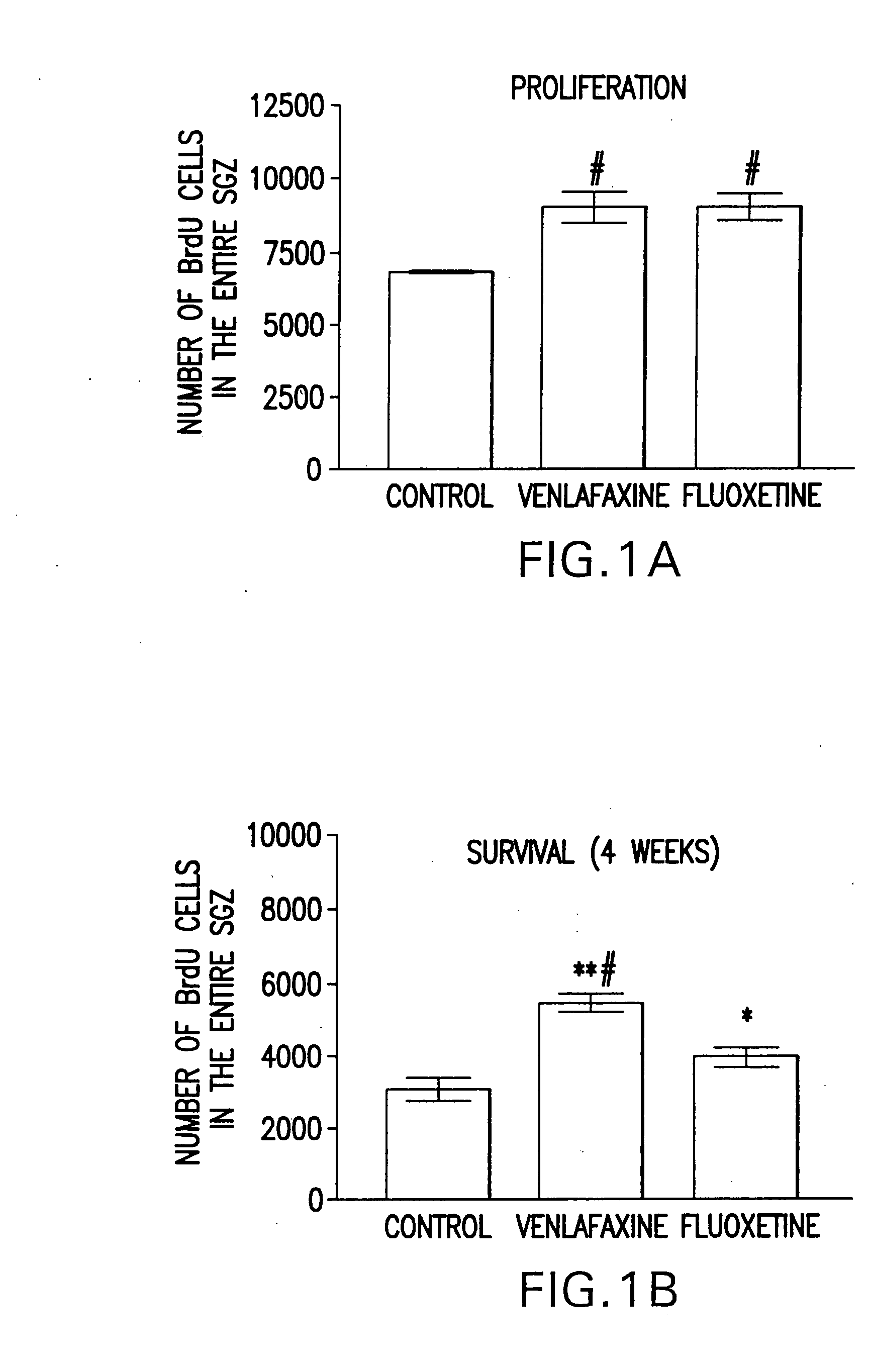Methods for diagnosing mood disorders
a mood disorder and diagnosis method technology, applied in the field of neuroscience, proteomics and mood disorders, can solve the problems of mood disorders associated with a significant risk of suicide, many structural and signaling components leading to antidepressant-mediated adaptive changes in the hippocampus and other areas of the brain remain poorly understood, and many structural and signaling components are not well understood
- Summary
- Abstract
- Description
- Claims
- Application Information
AI Technical Summary
Benefits of technology
Problems solved by technology
Method used
Image
Examples
example 1
Proteomic Analysis of Protein Changes Developing in Rat Hippocampus after Chronic Antidepressant Treatment
Materials and Methods
[0203]Animal dosing. Adult male Sprague Dawley rats weighing 230-320 g were housed with ad libitum access to food and water. After 1 week of habituation, rats were administered either an antidepressant or vehicle alone. The following drugs were administered intraperitoneally (i.p.): fluoxetine (10 mg / kg daily), venlafaxine (10 mg / kg daily) or vehicle alone (1 ml / kg normal saline daily) for 14 days (n=3 rats per group).
[0204]Sample preparation and cytosolic protein extraction. The animals were euthanized and hippocampi were rapidly dissected from the whole brain. Samples from each treatment group were pooled and stored at −85° C. Cytosolic extracts were prepared using the universal extraction kit from Sigma (prot-two) as follows: soluble cytoplasmic extraction reagent (S2688) was added to the hippocampal tissue (10 ml / 250 mg wet weight). Samples were sonicate...
example 2
Monitoring Monoamine Re-Uptake Inhibitor Kinetics In Vivo
[0217]Monoamine re-uptake inhibitors, such as fluoxetine and venlafaxine, exhibit slow response kinetics with regard to attenuation of mood disorder symptoms. For example, a patient receiving a fluoxetine treatment regimen typically requires about two weeks for an attenuation in depressive symptoms. The following non-limiting example describes a method for monitoring the kinetics of monoamine re-uptake inhibitors in viva. The method generally comprises administering to a plurality of rodents either a monoamine re-uptake inhibitor or a placebo. Then, at a desired time point, a hippocampus is obtained from one of the plurality of rodents administered the monoamine re-uptake inhibitor and a hippocampus is obtained from one of the plurality of rodents administered a placebo. The amount of one or more proteins in the hippocampus is then determined, wherein the proteins are IGF-1, GMF-β CRMP2, PCTAIRE-3, HCNP, hydroxysteroid sulfotr...
example 3
Monitoring Monoamine Re-Uptake Inhibitor Kinetics In Vitro
[0218]The following non-limiting example describes a method for monitoring the kinetics of monoamine re-uptake inhibitors in vitro. For example, recombinant cells are used that either endogenously express or are genetically engineered to express one or more of the proteins IGF-1, GMF-β, CRMP2, PCTAIRE-3, HCNP, hydroxysteroid sulfotransferase, pyruvate dehydrogenase, antioxidant protein-2 and / or DDAH-1. A plurality of the recombinant cells are administered a monoamine re-uptake inhibitor or a placebo. Subsequently, at a desired time point, a cell from one of the plurality of cells administered the monoamine re-uptake-inhibitor and a cell from one of the plurality of cells administered the placebo are obtained and the amount of one or more proteins (or mRNA) is determined. These measurements are repeated over a range of desired time points, e.g., from 0 days to about 36 days.
Equivalents: Those skilled in the art will recognize,...
PUM
| Property | Measurement | Unit |
|---|---|---|
| time | aaaaa | aaaaa |
| pH | aaaaa | aaaaa |
| Tm | aaaaa | aaaaa |
Abstract
Description
Claims
Application Information
 Login to View More
Login to View More - R&D
- Intellectual Property
- Life Sciences
- Materials
- Tech Scout
- Unparalleled Data Quality
- Higher Quality Content
- 60% Fewer Hallucinations
Browse by: Latest US Patents, China's latest patents, Technical Efficacy Thesaurus, Application Domain, Technology Topic, Popular Technical Reports.
© 2025 PatSnap. All rights reserved.Legal|Privacy policy|Modern Slavery Act Transparency Statement|Sitemap|About US| Contact US: help@patsnap.com


